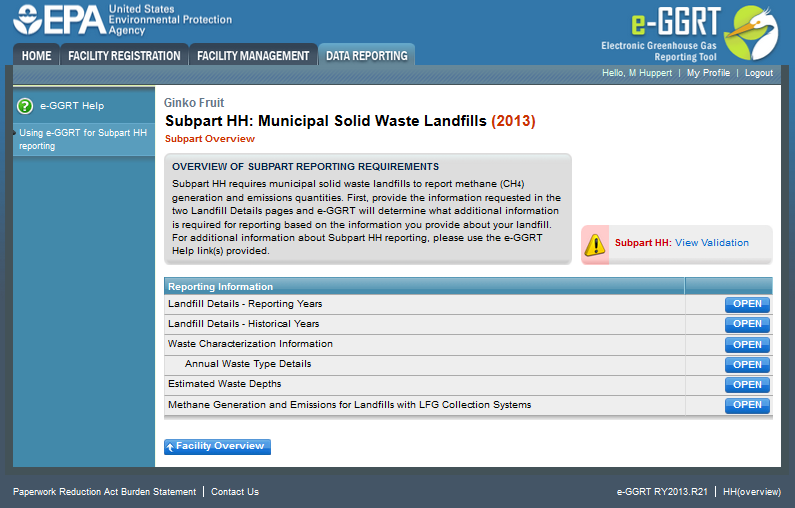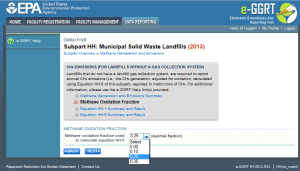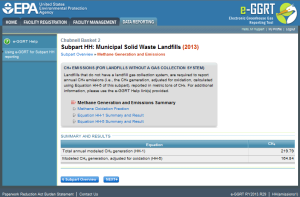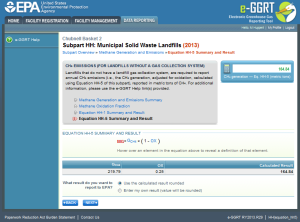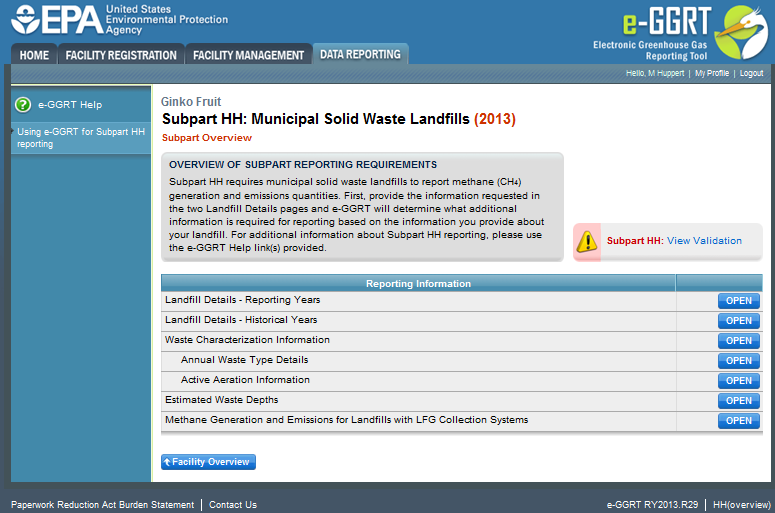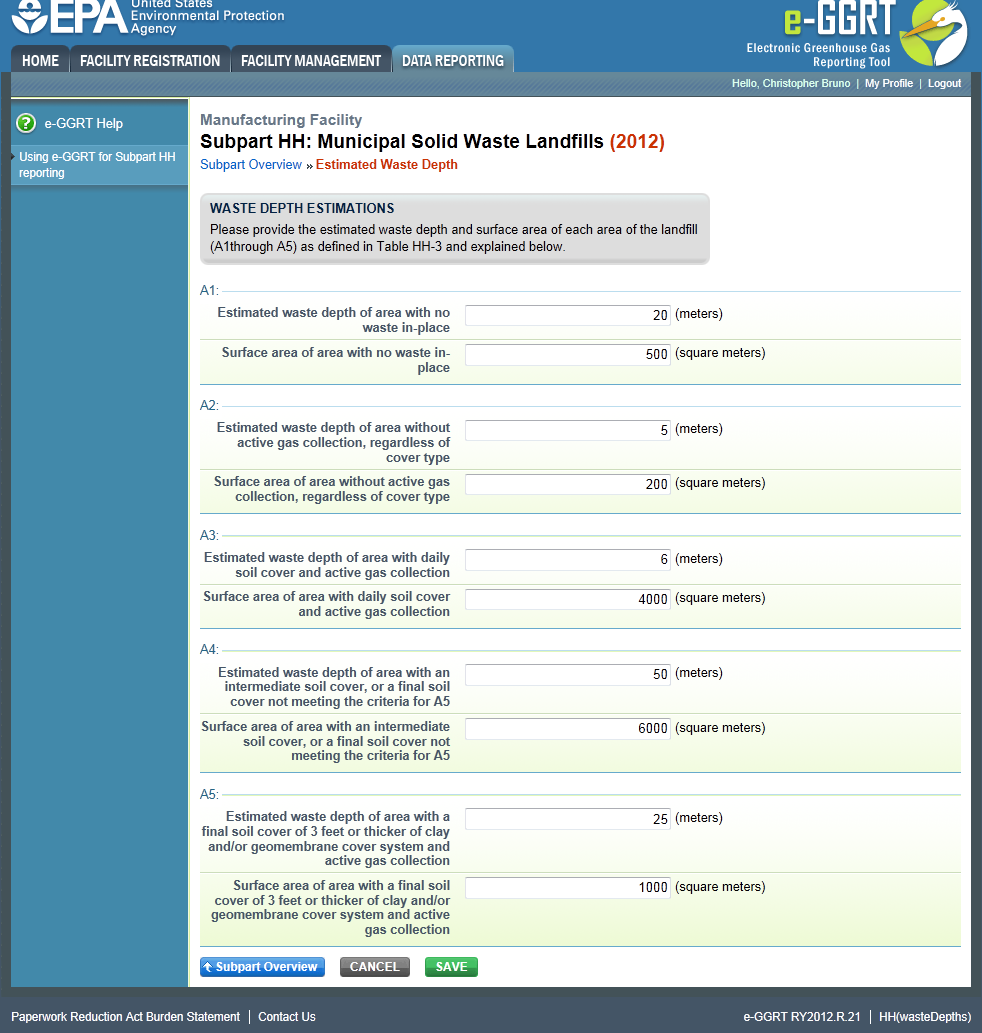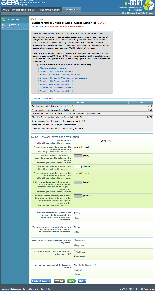Subpart HH applies to municipal solid waste (MSW) landfills that accepted waste on or after January 1, 1980.
This page provides an overview of sub-topics that are central to Subpart HH reporting:
- Subpart HH Summary Information for this Facility
- Subpart HH Waste Information
- Subpart HH Emissions Information
- Subpart Validation Report
- Carry forward of data from previous submissions into RY2012 forms
The end of this page contains links you can use for more information on these topics.
If you reported in RY2011, most historical data will be prepopulated in your RY2012 report. See the Carry forward of data from previous submissions into RY2012 forms for details.
Click image to expand
Summary Information for this Facility
Additional information about the facility is also collected in this section. Please go to Subpart HH Summary Information for this Facility for more details.
Waste Information
Additional information about the waste disposed at the facility is also collected in this section. Please go to Subpart HH Waste Information for more details.
Emissions Information
If there is no gas collection system at your landfill:
Click this link to expand
From the Subpart Overview page, click the OPEN button located opposite “Methane Generation and Emissions for Landfills without LFG Collection Systems.”
Click this link to expand
This page displays a summary of the CH4 data calculated by e-GGRT for the current reporting year based on data entered on previous and subsequent pages. Nothing needs to be reported on this page.
Click NEXT to move on to the "Methane Oxidation Fraction" page. Please note that the Methane Oxidation Fraction may only be provided for RY2013 and later. For reports submitted prior to RY2013, the default of 0.1 was used in all cases and the following methane oxidation fraction page is not available.
Please provide the Methane Oxidation Fraction for your landfill using the screen below. You must select one of the values from Table HH-4 of this subpart provided in the drop down menu, For assistance in determining the appropriate methane oxidation fraction for your facility, please consult the Methane Flux Calculation Spreadsheet .
Click this link to expand
Click NEXT to move on to the "Equation HH-1 Summary and Result" page.
For each equation:
- Hover over an element in the equation to read a definition of that element as needed.
- On these equation pages, you will have the option to use the result calculated by e-GGRT or enter your own result by clicking on one of the following radio buttons at the bottom of the page:
- "Use the calculated result rounded"
- "Enter my own result (value will be rounded)." If you click this radio button, you must enter an alternative value.
When performing the calculations, only the final number calculated by e-GGRT is rounded to two decimal places. e-GGRT does not round the values for any inputs used in the equations when performing the calculations. However, when an input to an equation is displayed, a rounded value will be presented.
Equation HH-1 Summary and Result
After clicking the NEXT button, you will be brought to the "Equation HH-1 Summary and Result" page. On this page, e-GGRT will display the annual modeled methane generation (GCH4) in metric tons per year (the output of Equation HH-1) that was calculated by the system based on data you previously entered, rounding the value according to e-GGRT rounding rules, and storing both the rounded and unrounded values in the database.
e-GGRT will also allow you to report the modeled annual methane generation (GCH4) in metric tons per year (the output of Equation HH-1). To enter a value, click the "Enter my own result" button and enter your result in the box that shows up below the question. e-GGRT will store your estimated value of modeled annual methane generation (GCH4) in metric tons per year (the output of Equation HH-1), round the value to the nearest metric ton, and store the rounded value and the facility-entered unrounded value in the database. If you enter your own value, that value will be used in any subsequent calculation for which this value is an input.
Click this link to expand
Click NEXT to move on to the "Equation HH-5 Summary and Result" page.
Equation HH-5 Summary and Result
On this page, e-GGRT will calculate the landfill's annual methane generation adjusted for oxidation using Equation HH-5. e-GGRT will then round the result according to e-GGRT rounding rules, and store both the rounded and unrounded values in the database.
You may use this result or enter your own value by clicking the "Enter my own result" button. Enter your result in the box that shows up below the question. e-GGRT will store your estimated value, round the value according to e-GGRT rounding rules, and store both the rounded and unrounded value in the database.
Note that for landfills with no gas collection system, the methane generation quantity that results from the HH-5 calculation (or the value that you entered) will serve as the landfill's total methane emissions and be used for total, facility-wide emissions rollups.
Click this link to expand
When you have entered the information, click NEXT. This will take you to the summary page where you can click SAVE. Then click Subpart Overview to return to the Subpart Overview page.
If there is a gas collection system at your landfill:
Click this link to expand
From the Subpart Overview page,press the OPEN button located opposite “Estimated Waste Depths.”
Click this link to expand
Estimated Waste Depths Overview
For landfills with a gas collection system in place, the following information must be entered on the estimated waste depths (in meters) and surface areas (in square meters) for each area type below (as listed in Table HH-3). If an area type, A1 through A5, is not found at the facility, enter zero for the surface area and waste depth for that area type. For each area type, A1 through A5, for which the surface area or waste depth is zero, enter a zero in that data field.
- A1: Depth and surface area of area with no waste in place. Note: In many cases, the depth of area with no waste in place will be zero.
- A2: Depth and surface area of area without active gas collection, regardless of cover type.
- A3: Depth and surface area of area with daily soil cover and active gas collection.
- A4: Depth and surface area of area with an intermediate soil cover, or a final soil cover not meeting the criteria for A5.
- A5: Depth and surface area of area with a final soil cover of 3 feet or thicker of clay and/or geomembrane cover system and active gas collection.
When you have entered the information, click SAVE. You will be brought back to the top of the “GHG Reporting” page at which time you may check over the information you entered. When you have completed your check, click Subpart Overview to return to the Subpart Overview page.
Emissions Reporting Overview
From the Subpart HH Overview page, click the OPEN button located opposite “Methane Generation and Emissions for Landfills with LFG Collection Systems.”
Click this link to expand
This action will open the Methane Generation and Emissions Summary page.
Click this link to expand
This page displays a summary of the CH4 data calculated by e-GGRT and has a link to each equation that must be calculated for landfills with gas collection.
On the first page, under the Summary and Result Table, the following information is collected:
- Total volumetric flow of landfill gas collected for destruction (in scf)
- Indicate if a missing data procedure was used to determine the volume of the landfill gas collected for destruction (information about appropriate procedures for estimating missing data is found in §98.345.
- If a missing data procedure was used, enter the number of days when substitute data were used to determine the volume of the landfill gas collected for destruction
- Annual average concentration of CH4 of landfill gas collected for destruction
- Indicate if a missing data procedure was used to determine the concentration of CH4 in landfill gas collected for destruction (information about appropriate procedures for estimating missing data are found in §98.345.
- If a missing data procedure was used and the CH4 concentration is monitored continuously, enter the number of days substitute data were used to determine the annual average CH4 concentration of landfill gas collected for destruction
- If a missing data procedure was used and the CH4 concentration is monitored monthly, enter the number of months substitute data were used to determine the annual average CH4 concentration of landfill gas collected for destruction
- In the case of multiple measurement locations, you may enter values for both days and months when CH4 concentration is measured continuously at some locations and monthly at others.
- Indicate (yes/no) if temperature was incorporated into internal calculations run by the collection system’s monitoring equipment
- If temperature was not incorporated into the internal calculations run by the collection system’s monitoring equipment, enter the average monthly temperature at which the landfill gas flow was measured (in degrees Rankine) for each month of the reporting year.
- Indicate (yes/no) if pressure was incorporated into internal calculations run by the collection system’s monitoring equipment
- If pressure was not incorporated into the internal calculations run by the collection system’s monitoring equipment, enter the average monthly pressure at which the landfill gas flow was measured (in atmospheres) for each month of the reporting year.
- Indicate whether landfill gas flow was measured on a wet or a dry basis and whether CH4 concentration was measured on a wet or a dry basis
- If landfill gas flow was measured on a wet basis and CH4 concentration was measured on a dry basis, or gas flow was measured on a dry basis and CH4 concentration was measured on a wet basis, provide the monthly average moisture content (expressed as a decimal fraction) for each month of the reporting year.
- Indicate whether landfill gas destruction occurred at the facility (on-site), off-site, or both.
Please note that for reports submitted for reporting years RY2010 through RY2012 data detailing on-site destruction efficiency and operating hours are also collected on this page. For RY2013 and later these data are collected on the Equation HH-4 Landfill Gas Measurement Locations Page.
When you have entered the information, click SAVE. You will be brought back to the top of the “GHG Reporting” page at which time you may check over the information entered. When you have completed your check, click NEXT to be taken to the next page for data input.
Emissions Reporting Equations
For each equation:
- Hover over an element in the equation to read a definition of that element as needed.
- The equation may be calculated by e-GGRT itself or by using a spreadsheet tool provided for each of the Subpart HH equations
- If a spreadsheet tool is available for download on the page, download the spreadsheet tool by clicking the link labeled “Use HH-n spreadsheet to calculate.”
- Fill in the spreadsheet completely using the instructions provided in the tool.
- After completing the spreadsheet, copy the value of CH4 calculated by the spreadsheet to this page in the corresponding box.
- On most equation pages, you will have the option to use the result calculated by e-GGRT or enter your own result by clicking on one of the following radio buttons at the bottom of the page:
- "Use the calculated result rounded"
- "Enter my own result (value will be rounded)" . If you click this radio button, you must enter an alternative value.
There will be a series of pages for these equations. You will have to click the NEXT button to get to the next equation page or you can use the links in the gray box at the top of each page to hop from equation to equation.
Equations include: HH-1, HH-3, HH-4, HH-5, HH-6, HH-7, and HH-8.
You will be allowed to elect to use either the rounded result of Equation HH-6 (as calculated and rounded by e-GGRT, unless entered by the user) or the rounded result of Equation HH-8 (as calculated and rounded by e-GGRT, unless entered by the user) to roll up into your total CO{~}2~e emissions from facility subparts as required by 98.3(c)(4)(i). If you make no election, e-GGRT will use the larger of the two rounded values.
Additional information about emissions at the facility is also collected in this section. Please go to Subpart HH Emissions Information for more details.
Validation Report
The Validation Report assists you with determining the completeness and quality of your reported data.We strongly encourage you to use the Validation Report to check your work. The Validation Report performs two types of checks:
- Data Completeness: Data required for reporting that are missing or incomplete.
- Data Quality: Data that are outside of the expected range of values.
Certain validation checks which are considered to represent critical errors must be corrected before you can successfully generate and submit your Annual Report. These checks are signified with a stop sign . If you feel that you have triggered one of these critical “stop signs” checks in error, or if there’s a reason why your report should be submitted despite the check being triggered, please submit a request to the e-GGRT Help Desk at GHGReporting@epa.gov.
You may view the Validation Report at any time.
Note that the Validation Report is intended to assist users in entering data, but it is not an indication that the reporter has entered all necessary information, nor is it an indication that the reporter is in compliance with part 98. Furthermore, a negative finding on the validation report is not a guarantee that a data element was entered incorrectly. For more detail on the Validation Report and its functionality please review the Subpart Validation Report page.
RY2010 and RY2011 Data Carry-over
If you reported historical data prior to RY2012, your data will automatically be migrated to your RY2012 report. This includes data for the historical waste quantity estimation method, landfill gas collection system, waste disposal information, and waste type details. Historical data should be verified for completeness and accuracy. Please go to Carry forward of data from previous submissions into RY2012 forms for more details.
Click image to expand
See Also
Screen Errors
Subpart HH Summary Information for this Facility
Subpart HH Waste Information
Subpart HH Emissions Information
Subpart Validation Report


